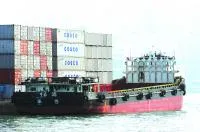
Empty vessels don't make waves
With the shipping industry in the doldrums, we speak to Raymon Krishnan, President of the Logistics & Supply Chain Management Society and Alex Schulz from Safe Haven Maritime discusses the increase in laid up vessel at OPL.
What are the cost benefits of laying up a vessel?
Krishnan believes that since global shipping demand has not increased significantly in the last quarter. The carriers have resorted to laying up vessels to control the downward spiral of freight prices. This was a successful measure to balance supply and demand. Alex Schulz from Safe Haven Maritime believes that the benefits of anchoring are that the vessel can resume trading faster and anchor in international waters without any port costs applicable. “OPL Singapore only qualifies for anchoring and not lay-up while inside port limits of Singapore a vessel can be laid-up. For anchoring in international waters there are no port costs although there are high manning and high insurance costs. For anchoring within approved lay-up area there are reasonable port cost & fees to the area manager, low or no manning costs, but hefty rebates for insurance and hefty rebates of flag state costs. Overall cost much lower for within approved lay-up area,” added Schulz.
How has the decline in freight prices affected the industry?
Krishnan believes the downward spiral of freight prices has stabilized somewhat when compared to the first quarter of this year. “From a bottoming out of the market that happened in June – July of this year we are now looking at carriers implementing general rate increases and rate restoration programmes for freight and bunker. Since August rates have increased by as much as 15% in most trade lanes and we can expect to see even higher increases as we enter 2010. This works out to be between US$150 – US$300 per. Carriers are being ‘cautiously optimistic’ as recovery is slow and there are no specific growth trends with the overall outlook in the industry matching what market experts predict, we can expect things to return to pre 2009 performance in Q3 of 2010.”
Schulz believes that that as a result of the decline in freight prices there are about 77 vessels anchored at OPL West and about 118 vessels at OPL East, mostly in very close proximity without any applicable regulatory authority overseeing the activities, we have witnessed countless accidents where vessels collide into each other. “While some of the vessels at “OPL Singapore” are up to fully loaded most of the vessels at “OPL Singapore” are anchored without any cargo aboard.
Where will these cargo ships head to in the next 6-12 months?
“As has been the case in the past year, older vessels are being scrapped earlier. Delivery dates on new builds are being delayed by as much as possible or in some circumstances orders for new builds are being cancelled. Vessels are being diverted to high volume / demand routes such as the Intra- Asia lanes or vessels charter rates are dropping to more realistic figures that allow owners to maintain vessels and crew with a small margin. Crews are getting shore based jobs where possible such as taking up positions in Ship or Logistics Management.” Said Krishnan.
Schulz said that the condition of a vessel deteriorates very fast without proper maintenance and preservation necessitating hefty repair and upgrade costs when the vessel is to be brought out into trade again at a later stage. “The three forms of lay-up - hot stacking, cold stacking and semi cold stacking. generally depend on the length of time a vessel owner expects the vessel to remain in lay-up and whether or not the owner expects the vessel to go back into normal trade after completed lay-up - some vessels will be scrapped after completed lay-up, and owners will wait for steel prices to increase so they can get more for the vessel they will scrap,” he said.



![SBR 5 Lorem Ipsum News 2 [8 May]](https://cmg-qa.s3.ap-southeast-1.amazonaws.com/s3fs-public/styles/exclusive_featured_article/public/2025-05/a_hand_pointing_to_a_futuristic_technology_5b87c9d0e3_3.png.webp?itok=M3Hf-9XR)
![SBR 4 Lorem Ipsum [8 May Top Stories]](https://cmg-qa.s3.ap-southeast-1.amazonaws.com/s3fs-public/styles/exclusive_featured_article/public/2025-05/a_hand_pointing_to_a_futuristic_technology_5b87c9d0e3_2.png.webp?itok=2m5Wl0MX)


![Exclusive three SBR 12 Lorem Ipsum [8 May]](https://cmg-qa.s3.ap-southeast-1.amazonaws.com/s3fs-public/styles/exclusive_featured_article/public/2025-05/a_hand_pointing_to_a_futuristic_technology_5b87c9d0e3_11.png.webp?itok=8kn_UIfA)
![SBR 3 Lorem Ipsum [ Exclusive 2]](https://cmg-qa.s3.ap-southeast-1.amazonaws.com/s3fs-public/styles/exclusive_featured_article/public/2025-05/a_hand_pointing_to_a_futuristic_technology_5b87c9d0e3_1.png.webp?itok=YCyjLegJ)
![SBR 2 Lorem Ipsum [8 May]](https://cmg-qa.s3.ap-southeast-1.amazonaws.com/s3fs-public/styles/exclusive_featured_article/public/2025-05/a_hand_pointing_to_a_futuristic_technology_5b87c9d0e3_0.png.webp?itok=_cKD-29o)

![Video [Event News]](https://cmg-qa.s3.ap-southeast-1.amazonaws.com/s3fs-public/styles/event_news_featured_article/public/2025-05/screenshot-2025-05-08-at-4.58.53-pm_0.png.webp?itok=Kud35sMs)
![Event News SBR 9 Lorem Ipsum [8 may]](https://cmg-qa.s3.ap-southeast-1.amazonaws.com/s3fs-public/styles/event_news_thumbnail/public/2025-05/a_hand_pointing_to_a_futuristic_technology_5b87c9d0e3_8.png.webp?itok=DTh_dbYp)
![Event News SBR 9 Lorem Ipsum [8 May]](https://cmg-qa.s3.ap-southeast-1.amazonaws.com/s3fs-public/styles/event_news_thumbnail/public/2025-05/a_hand_pointing_to_a_futuristic_technology_5b87c9d0e3_7.png.webp?itok=vzDAzb6V)
![Event News SBR 8 Lorem Ipsum [8 May]](https://cmg-qa.s3.ap-southeast-1.amazonaws.com/s3fs-public/styles/event_news_thumbnail/public/2025-05/a_hand_pointing_to_a_futuristic_technology_5b87c9d0e3_6.png.webp?itok=jvHFc4P6)
![Video [Event News]](https://cmg-qa.s3.ap-southeast-1.amazonaws.com/s3fs-public/styles/video_thumbnail/public/2025-05/screenshot-2025-05-08-at-4.58.53-pm_0.png.webp?itok=yZnI0YBb)
![Video 1 SBR [8 May]](https://cmg-qa.s3.ap-southeast-1.amazonaws.com/s3fs-public/styles/video_thumbnail/public/2025-05/screenshot-2025-05-08-at-4.58.53-pm.png.webp?itok=9AAeRz_k)

 Advertise
Advertise

